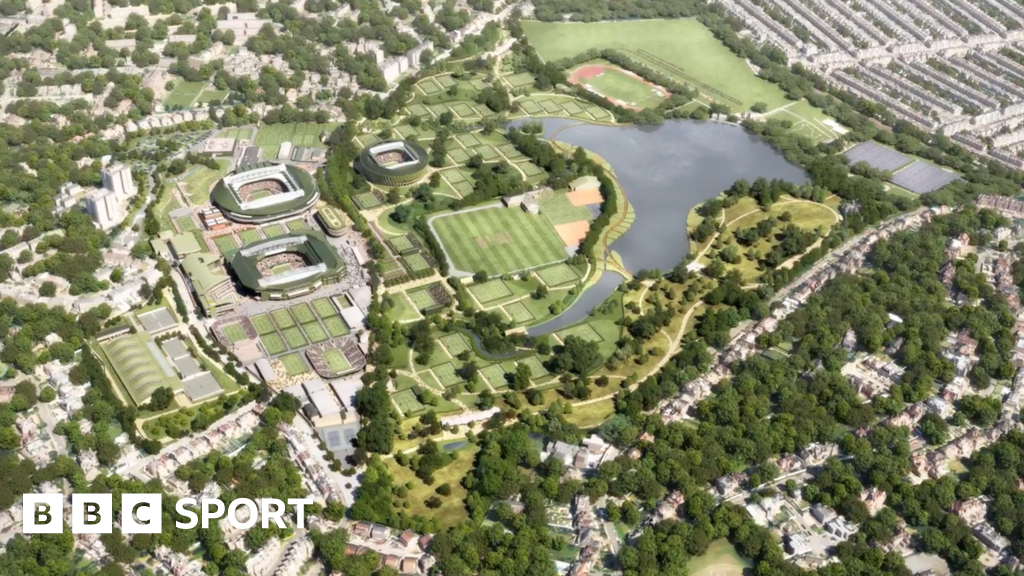A new era of the Wimbledon Championships is on the horizon, as plans for an expanded site, including a state-of-the-art 8,000-seater stadium with a retractable roof and on-site qualifying, have taken a significant step forward. Merton Council’s planning committee has given the green light to the construction of 39 new courts on the former site of the Wimbledon Park Golf Club, located across the road from the All England Club (AELTC). In a vote of six to four, councillors approved the scheme during Thursday’s meeting, although local opposition remains strong.
The meeting concluded abruptly after the vote when a spectator in the public gallery shouted that the council chamber had become a “climate crime scene”. The proposed development is not expected to be operational until at least 2030. Planning officers initially expressed concerns over potential damage to Metropolitan Open Land, but ultimately determined that the “substantial public benefits would clearly outweigh [the] harm” due to the “very special circumstances” surrounding the project.
Ahead of the meeting, around 75 members of the Save Wimbledon Park organisation gathered outside the chamber to express their concerns. Protest signs read, “It’s just not tennis,” and “Stop corporate ecocide.” During the meeting, opponents of the plans described them as “too big, too harmful”, with claims that the All England Club would be the primary beneficiary. However, supporters of the scheme highlighted the anticipated economic benefits and referred to it as a “game-changing application”.
So, how will Wimbledon change? The All England Club intends to construct 39 new grass courts, which will include an 8,000-seater show court on the land previously occupied by the Wimbledon Park Golf Club. TV presenters Piers Morgan, Ant McPartlin, and Declan Donnelly, who were previously members of the golf club, received £85,000 each when the AELTC purchased the remaining lease in 2018 for £65m. The addition of these courts will allow the qualifying rounds of Wimbledon to be held on site, aligning it with the other three Grand Slam tournaments. Currently, the qualifying rounds take place three-and-a-half miles away at the Bank of England Sports Centre in Roehampton, which offers subpar facilities and can only accommodate about 2,000 spectators per day.
The expanded site will enable up to 10,000 people to watch the qualifying rounds each day and up to 50,000 visitors to enter the grounds during each day of the main tournament. The new show court, standing 28 metres above ground level and surrounded by oak trees with climbing plants on the walls, will have a seating capacity of 8,000 and a retractable roof. This aligns with Wimbledon’s goal of having another large show court that can host matches regardless of the weather conditions.
The decision to preserve the championship courts has often resulted in players having to share practice courts at Wimbledon. However, with the addition of new courts, this issue will be resolved. The All England Club has also pledged to double the size of the wheelchair draw, a move that many feel could be achieved even without the expansion.
As part of the development, a new 23-acre public park will be created, accessible free of charge year-round, except during the weeks of the Championships. The aim is to restore some of the original design by Lancelot ‘Capability’ Brown, an esteemed 18th Century landscape architect known for his elegant and natural-looking landscapes. Plans include the removal of silt from the lake and the installation of a new boardwalk. Additionally, at least seven of the grass courts will be made available to the local community during the summer weeks following Wimbledon.
Apart from improving health and wellbeing, a 450-page report by Merton Council concluded that the development would have positive economic impacts and create more employment opportunities in the local area.
However, despite these anticipated benefits, opposition to the plans remains strong among many local residents. Wimbledon’s Conservative MP, Stephen Hammond, and Putney’s Labour MP, Fleur Anderson, expressed their joint opposition to the proposal. The Wimbledon Society referred to the plans as an “industrial tennis complex with an unacceptable environmental impact,” while the Capability Brown Society claimed that the expansion posed a threat to the celebrated park originally designed by the architect. A petition by the Save Wimbledon Park group, which raises concerns about environmental impact and the loss of trees and open spaces, has garnered over 13,000 signatures. Additionally, Merton Council received 894 objections, with some participants in the AELTC’s consultation process expressing strong criticism. One response described the club as “an insular and imperial group of expansionists who see little beyond the net,” while another said, “The AELTC is a juggernaut without brakes – a project like this will completely destroy an oasis of space and tranquility.” Concerns range from the potential disruption of views and increased traffic and noise to the environmental impact during six years of construction. Critics also voice reservations about the removal of 296 trees, although the AELTC plans to replant 1,500 new trees and has argued that most of those being cut down are of poor quality and have a short life expectancy. Additionally, objections are raised about the increased number of spectators allowed on site each day, suspicions that the AELTC’s ultimate goal is to build a hotel complex, and frustration over the annual closure of Church Road during the Championships.
Yet, the fate of the AELTC’s plans is not yet sealed. The northernmost part of Wimbledon Park falls within Wandsworth’s jurisdiction, and its planning committee must also approve the scheme. The meeting is expected to take place before the end of the year. Subsequently, as the development will occur on Metropolitan Open Land, the Mayor of London, Sadiq Khan, will need to formally accept or reject the decisions made by the councils. Khan has two weeks following Wandsworth’s decision to deliver his verdict. He could also choose to take over the application himself, a potential course of action available to the Secretary of State for Levelling Up, Housing, and Communities, Michael Gove.
The possibility of a judicial review poses a significant threat to the AELTC’s plans. As emotions run high among some affluent local residents, an attempt may be made to challenge the lawfulness of the decision based on claims of illegality, procedural unfairness, or irrationality. However, successful challenges of this nature are relatively rare. Another potential obstacle stems from a 30-year-old legal covenant. In 1993, when Merton Council transferred the freehold of the golf course to the AELTC, the club agreed not to use the land for any purpose other than leisure, recreation, or as open space. Resolving this issue will be necessary before any construction can commence on a development that the All England Club hopes will maintain Wimbledon’s status as the “pinnacle of the sport”.

Jessica Roberts serves up the latest in the world of tennis. With a love for the racket sport, she reports on tennis matches, player rankings, and Grand Slam events, ensuring readers stay informed about the tennis world.




:no_upscale()/cdn.vox-cdn.com/uploads/chorus_image/image/72931262/usa_today_21973134.0.jpg)


